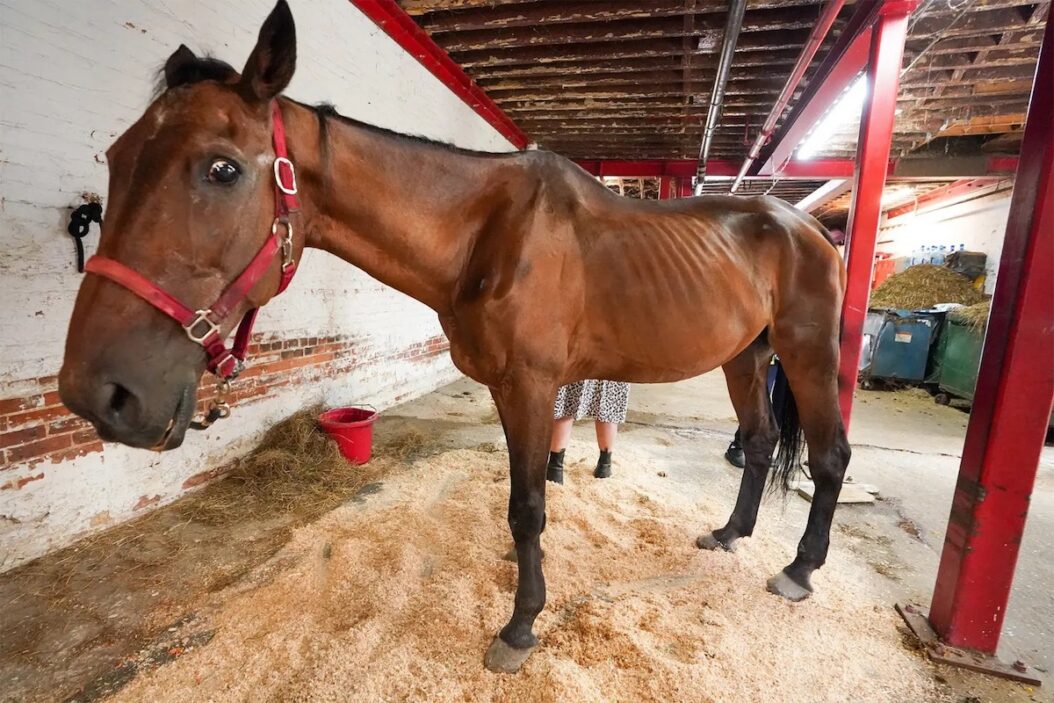Lack of oversight raises concerns about care for all horses in commercial carriage industry
New York City — Jim Keen, D.V.M., director of veterinary services for the Center for a Humane Economy and Animal Wellness Action, issued a veterinary review and analysis of the condition of Ryder, an elderly gelding who went down during the workday on Wednesday, August 10.
“This was a malnourished, underweight, overage and possibly diseased horse suffering from a parasitic neurological disease,” wrote Dr. Keen in his report.
“There’s no excuse for this series of gross missteps by the veteran owner of the horse or the other regulatory authorities. Ryder was both ineligible and unfit for service. He was in no condition to pull a carriage for nine hours per day based on these multiple serious disqualifying indicators.”

Dr. Keen’s review is built on information assembled in the wake of the world-shocking incident, which occurred in the Hell’s Kitchen neighborhood of New York City earlier this month. Photos of the stricken horse as he lay on a city street went viral and made headlines across the globe as animal-lovers gasped in shock. A video of the owner of the horse shows him flogging Ryder in vain attempt to get the animal back to his feet.
Dr. Keen was graduated with his veterinary medicine degree and doctorate in epidemiology from the University of Illinois College of Veterinary Medicine. He has 30 years of experience in veterinary and biomedical research, with a specialty in livestock infectious-disease issues and public health and animal welfare. He worked for nearly 20 years at the U.S. Department of Agriculture’s National Meat Animal Research Center and for nearly 15 years as a faculty member at the University of Nebraska School of Veterinary Medicine and Biomedical Sciences. He lives on his family’s 140-acre farm in eastern South Dakota.
Here is Dr. Keen’s report in full:
Veterinary Review and Analysis on the Breakdown of Standardbred Horse on New York City Street While Working in the Carriage Horse Industry.
Ryder, a New York City Central Park carriage horse, collapsed on the pavement in evening rush hour traffic for more than an hour in the Hell’s Kitchen neighborhood on August 10 after working nine hours in the summer heat.
A just-released and startling incident report on Ryder’s collapse from the New York City Mounted Police reveals multiple failures in humane treatment controls by regulatory authorities and the owner. Had basic controls been in place, Ryder would not have collapsed on the city street; in fact, it’s unlikely he would have been conscripted for this work in the first place.
These multiple failures occurred even though the industry is under enormous scrutiny and with the serious threat of legislative action. For these failures to occur at this time suggests a culture of indifference on the part of the carriage industry to the well-being of their horses.
After his collapse on the street, the NYPD mounted unit brought Ryder back to the horse carriage industry stable. There were two especially incriminating details in the police report based on real-time diagnoses by the industry’s attending veterinarian:
- Ryder is twice as old as was reported by industry officials. Ryder’s owner said he is 13 years old, but the veterinarian says he is twice that old. This horse was estimated to be 28 to 30 and yet was working a full day on the streets—even though it is illegal for an NYC carriage horse to exceed 26 years of age. A 28- to 30-year-old full-sized horse corresponds roughly to an 86- to 91-year-old person.
- Ryder was also diagnosed as “malnourished and underweight” and possibly suffering from Equine Protozoal Myelitis (EPM) based apparently on an earlier blood test. In my opinion from afar, I estimate that Ryder’s body condition was a 2 on the Henneke scale, i.e., emaciated and very thin. No horse scoring that low on body condition should be pulling an 1800-pound cart, no less on a day with temperatures flirting with the 90-degree mark. Apart from the veterinary report, multiple eyewitnesses reported that Ryder stumbled and fell to his knees in a near breakdown earlier on the afternoon of his August 10 evening street collapse.
Every single one of these details should have kept Ryder off the streets, either permanently or on that day. His elder status requires retirement under the law. Age aside, his body score condition should have kept him in the stables at least until he was in better shape. And the owner should never have allowed him to continue to work after he stumbled and went down on his knees four hours before his collapse on the streets of Hell’s Kitchen.
This information incriminates multiple people involved in the carriage horse trade. This was a malnourished, underweight, overage, and possibly diseased horse suffering from a parasitic neurological disease. There’s no excuse for this series of gross missteps by the veteran owner of the horse or the other regulatory authorities.
Ryder was both ineligible and unfit for service. He was in no condition to pull a carriage for nine hours per day based on these multiple serious disqualifying indicators.
These findings, in my opinion, represent a colossal example of extremely poor management of carriage horses in NYC by multiple responsible parties but where no one seems willing to take responsibility:
- The carriage horse owner and driver forced a clearly unfit and sick horse into carriage pulling duty. This is particularly distressful and inexcusable given that Ryder’s owner-driver was reported to have 30 years of experience in the carriage industry.
- The city of New York, which approves each horse as fit for carriage work, obviously failed on its oversight mission.
- Professional veterinary care, judgment, and supervision were lacking.
Equine protozoal myelitis (EPM) infection without clinical disease is extremely common in U.S. horses, with perhaps 50 percent or more of American horses testing positive based on serology (blood antibodies against the opossum parasite) but fewer than 1 percent becoming clinically diseased.
It is highly doubtful, in my opinion, that Ryder could have pulled a carriage for the previous weeks and months while suffering from an active parasitic disease that attacks the horse’s central nervous system. Ryder’s EPM was much more likely to be inactive and subclinical. There is no need to invoke EPM as an excuse, given his poor body condition and muscle wastage and extreme heat and humidity, to account for his August 10 collapse. No matter the cause of his condition, however, his low body score should have caused any attending veterinarian to disqualify him from work.
If a geriatric horse in such poor working condition as Ryder can be turned out to work, NYC’s regulatory and veterinary oversight has structural problems. The question is, how many other horses also are unfit for carriage service?
A formal, independent carriage horse health and welfare investigation of all NYC carriage horses should be conducted during a one-month-long cessation of all carriage horse operations. The city of New York should also review its oversight procedures and policies. The carriage industry should take stock of their role and responsibility in ongoing and persistent carriage horse deaths, injuries and collapses.
The carriage horse is not a machine to be run into the ground, underfed, and over-worked. It is a working service animal that deserves and needs proper care and respect.

